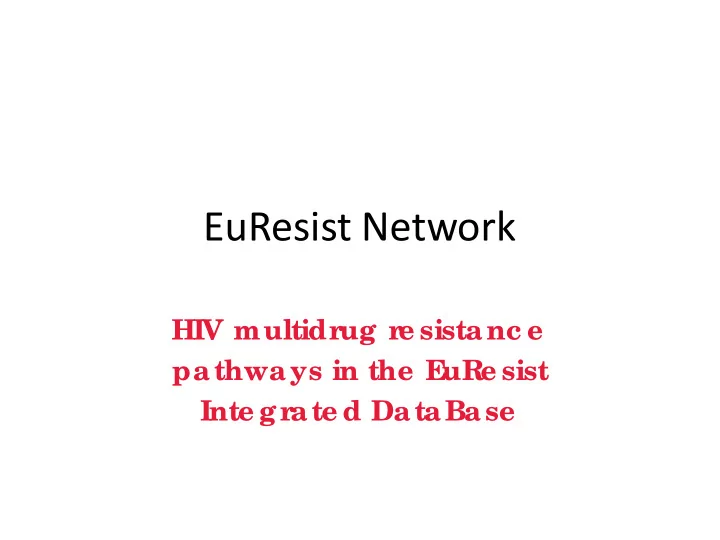

EuResist Network HIV multidrug re sistanc e pathways in the E uRe sist Inte grate d DataBase
Background on HIV MDR Small proportion of HIV patients • – Mostly but not exclusively generated during early ART era, e.g. suboptimal and sequential therapy – Poor adherence to ART often a key factor No consensus on MDR definition • – What level of resistance – How many inactive drug classes – How many inactive drugs within a class Challenging management • – Often receiving novel drugs as soon as available, sometimes using functional monotherapy – Treatment fatigue, comorbidities and drug-drug interactions may further complicate ART options – Not even considered in most guidelines
HIV MDR study aims • Estimating the prevalence and trend over time of MDR as based on different definitions • Identifying factors associated with development of MDR • Deriving successful treatment strategies in MDR patients
HIV MDR virological ancillary study • Investigating specific cases with unexpected ART failure or unexpected ART success – Unexpected with respect to what predicted by GSS – Subject to sample availability • NGS testing for minority virus population • Phenotypic testing of old and novel drugs • Investigating the role of off-target regions, e.g. PPT for IN resistance
HIV MDR study Exploratory analysis • 52,291 patients • Stanford HIVdb v. 8.8 scoring At least high-level resistance for one drug in each of the four classes At least intermediate resistance for one drug in each of the four classes At least low-level resistance for one drug in each of the four classes 0 50 100 150 200 250 Number or patients
Indicators for definition of MDR Number of classes with at least one drug falling in intermediate • resistance Number of classes with at least one drug falling in full resistance • A normalized score (0...1) indicating residual treatment options for • each of the 4 main classes A normalized global score (0...1) indicating global residual • treatment options derived from the scores of the individual classes Something more clinically relevant ? •
How to deal with missing sequences • Integrase, gp41 or gp120 sequences not always available for patients using INSTIs, T20, MVC • T20 and MVC – Full resistance if documented virological failure to the drug • INSTI – Full resistance to all INSTIs if documented virological failure to DTG/BIC – Full resistance to RAL/EVG and intermediate resistance to DTG/BIC if documented virological failure to RAL/EVG
How to compute MDR over time • Analysis based on cumulative genotype • MDR case assigned to the first year when cumulative genotype (and failure data) meet the definition of MDR • How to debias the denominator and derive reliable estimates of prevalence and incidence
National registries The PRESTIGIO registry in Italy • Originally requested by the Italian drug agency (AIFA) to monitor the safety of DTG 50mg BID • Later expanded to include a large set of clinical and virological data from patients with – Documented resistance to NRTI, NNRTI, PI and – Documented resistance to INSTI or documented virological failure to INSTI in the absence of IN genotype information • About 300 patients enrolled of the estimated 500-800 living in Italy • Very active group! Monthly TC • Patient cases discussed on line • Research studies already published and presented at CROI 2019 (BIC, • Fostemsavir) Ongoing studies on DOR and PRO-140 •
During a median follow-up of 17.5 (9.7-33.8) months in 191 patients, 62 treatment failures (TF) and 48 virological failure (VF) events occurred 27 (14%) pts discontinued DTG (10 VF, 9 clinical reasons, 4 deaths due to disease progression, 2 patient’s decision, 1 lost to follow-up, 1 adverse event) TF – 47% at 48 months VF – 39% at 48 months Castagna, JAC 2017
24 patients enrolled in the PRESTIGIO cohort (4-class resistance, with INSTI resistance demonstrated by genotype or inferred from virological failure of INSTI regimen(s) TMR RAMs (one S375N and two M426L) were detected in 3/23 samples and the polymorphic RAM M426L was associated with variable reduction of TMR susceptibility. Except for viruses harbouring M426L, the susceptibility to TMR was comparable to wild- type strains in all the samples, irrespective of coreceptor usage or exposure to other entry inhibitors. Saladini, CROI 2018
BIC retained activity against most isolates derived from patients harbouring a multi-drug resistant virus and who failed in their history INSTI regimens Reduced susceptibility to BIC and DTG was associated with presence of G140S + Q148H and often at least one another substitution consisting of L74M, T97A, S119P/T, E138A/K, or Y143C/R/H and G163R in IN These data support the study of BIC once daily in patients with INSTI-resistance Santoro, CROI 2018
Recommend
More recommend